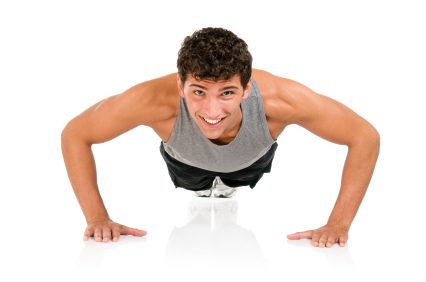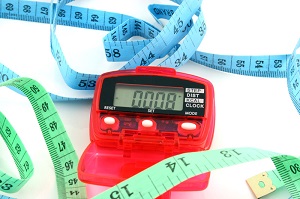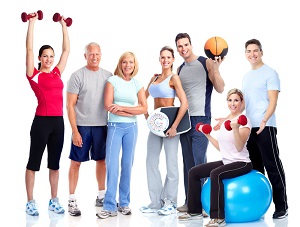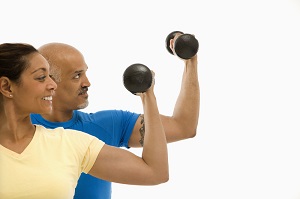 Nowadays, the average gym junkie never works out on the floor. Foam roaming is the furthest they will go to the ground. With all the fancy and sophisticated machines around, you may be wondering what the point is. However, experts in fitness field have argued that doing groundwork at the gym comes with a lot of benefits. Here are a few reasons why you should start to incorporate bodyweight exercises into your workouts.
Nowadays, the average gym junkie never works out on the floor. Foam roaming is the furthest they will go to the ground. With all the fancy and sophisticated machines around, you may be wondering what the point is. However, experts in fitness field have argued that doing groundwork at the gym comes with a lot of benefits. Here are a few reasons why you should start to incorporate bodyweight exercises into your workouts.
Training on the floor reduces fall-related injuries.
This advantage is most overlooked. Every year, a large number of people die from falls. By doing groundwork, you reduce your chances of being seriously injured from a fall because you improve your ability to break the fall.
Gets the heart pumping.
Going down and getting up from the floor gets your heart pumping. You can also increase your pulse by adding a set of bird dogs. A combination of push-ups and kettle bell swings do improve the heart beat rate.
It keeps you youthful.
Research has shown that people with difficulties in lowering their bodies to the floor and rising back up are far more likely to die within the next 6 years than those who are able to do so comfortably. The ability to stand up with ease and without pain from the floor surface is a good indication of how physical fit one is. Physical strength, flexibility and coordination for all ages are good tests for physical fitness according to researchers.
Increase flexibility.
By working out using just the ground and your bodyweight, you naturally use a full range of motion. This ensures that your joints are moving freely, leading to improved postured and again reducing the risk of getting injured.
Keep thing fun and fresh
It’s really easy to get stuck doing the same workout routine of bench presses, squats, sit ups, lat pulls over and over again. That’s why groundwork can be extremely refreshing. Not only are there variations of exercises you can do, it gives your body a new challenge, working out different muscles that may be ignored. Moreover, it can help break the common gym plateau – and stops you from becoming bored.
Increase athleticism
Due to the use of compound movement’s i.e numerous joints and muscles are engaged in each move, bodyweight exercises can give you amazing results. For instance, doing compound exercises such as lunges and push-ups have been proven to increase performance and strength. Furthermore research shows that improved core strength gained through bodyweight exercises also increases your strength throughout the entire body
So next time you go to the gym, think twice about skipping groundwork. Give it a try and you see the fantastic results that come with doing groundwork!
For more articles go to http://clubonefitness.lifestyleezine.com

 It is common for people to make New Year’s resolutions year in, year out. But the hard part is seeing those resolutions through. Hitting the gym or eating right is usually number two or three on the list right after quitting a bad habit or looking for a better career.
It is common for people to make New Year’s resolutions year in, year out. But the hard part is seeing those resolutions through. Hitting the gym or eating right is usually number two or three on the list right after quitting a bad habit or looking for a better career. The ankle is a physically active part of the body. The ankle consists of several ligaments that connect the bones and are required for proper function. There are also many muscles that also help support the ankle during activity. Building strength and proprioception, or special awareness, in these muscles helps to prevent injury and improve performance. Often, the most neglected body part in exercise is the ankle. There is no single sport that doesn’t involve the ankle in some way. It is important that we don’t forget about this joint and make sure we do what we can to make it strong and sturdy. A major benefit with strong ankles is that you can help reduce the risk of injury.
The ankle is a physically active part of the body. The ankle consists of several ligaments that connect the bones and are required for proper function. There are also many muscles that also help support the ankle during activity. Building strength and proprioception, or special awareness, in these muscles helps to prevent injury and improve performance. Often, the most neglected body part in exercise is the ankle. There is no single sport that doesn’t involve the ankle in some way. It is important that we don’t forget about this joint and make sure we do what we can to make it strong and sturdy. A major benefit with strong ankles is that you can help reduce the risk of injury. Sometimes we get into a slump and just need someone, or even something to get us going to get our exercise in. Getting into shape, losing weight, and moving more each day are all really tough to do. An activity tracker can help. Technology these days can be just that thing. Many people are now sporting a new fit tool, usually a Fitbit or pedometer tool that is strapped onto the wrist. There are also many fitness applications that you can download onto your smartphone. It can be a great way to keep you accountable to what you are doing during the day. It may just be that push you need. At the very least, it will make you more mindful of your present activity level, which is a good step to getting fit.
Sometimes we get into a slump and just need someone, or even something to get us going to get our exercise in. Getting into shape, losing weight, and moving more each day are all really tough to do. An activity tracker can help. Technology these days can be just that thing. Many people are now sporting a new fit tool, usually a Fitbit or pedometer tool that is strapped onto the wrist. There are also many fitness applications that you can download onto your smartphone. It can be a great way to keep you accountable to what you are doing during the day. It may just be that push you need. At the very least, it will make you more mindful of your present activity level, which is a good step to getting fit.  Athletes know that getting enough rest after exercise is essential to high level performance. Although you may feel guilty when you take a day off from exercising, it is important to help the body with repairs. A rest day will also help strengthen your body in the time between workouts. Continuous training can actually weaken even the strongest athletes.
Athletes know that getting enough rest after exercise is essential to high level performance. Although you may feel guilty when you take a day off from exercising, it is important to help the body with repairs. A rest day will also help strengthen your body in the time between workouts. Continuous training can actually weaken even the strongest athletes. Kick start the New Year by getting on the right track to keeping your resolutions. Most people choose to get healthier and a great way to start out right is to try something new for 2015. Stay motivated by doing different exercises to reach your goals, or to stay focused on your fitness. Doing the same thing day after day can lead to boredom and even giving up on your routine all together.
Kick start the New Year by getting on the right track to keeping your resolutions. Most people choose to get healthier and a great way to start out right is to try something new for 2015. Stay motivated by doing different exercises to reach your goals, or to stay focused on your fitness. Doing the same thing day after day can lead to boredom and even giving up on your routine all together. The Foam Roller can be a life saver when it comes to stretching and helping with minor injuries. Rolling your body over foam cylinders can improve flexibility, reduce post-workout soreness, prevent sports injuries and even alleviate chronic pain.The foam roller is a great tool for lengthening and elongating muscles and is especially helpful for runners who often suffer from tight and fatigued muscles. The foam roller will also massage the muscles intensely, similar to what a massage therapist will do without the cost to visit one.
The Foam Roller can be a life saver when it comes to stretching and helping with minor injuries. Rolling your body over foam cylinders can improve flexibility, reduce post-workout soreness, prevent sports injuries and even alleviate chronic pain.The foam roller is a great tool for lengthening and elongating muscles and is especially helpful for runners who often suffer from tight and fatigued muscles. The foam roller will also massage the muscles intensely, similar to what a massage therapist will do without the cost to visit one. Sitting all day at a desk can ruin what you’ve worked so hard for at the gym. What can you do to keep fit and healthy at work? There are many ways to exercise while working at your desk in the office each day. Don’t let your hard work go down the drain.
Sitting all day at a desk can ruin what you’ve worked so hard for at the gym. What can you do to keep fit and healthy at work? There are many ways to exercise while working at your desk in the office each day. Don’t let your hard work go down the drain. Men are from Mars and women are from Venus. There is a lot of differences between men and women; let it be in physical appearance or in the functioning of the body’s organs. Do men lose weight faster?The simple truth is that men are larger and have more muscle than women due to the hormone testosterone. They are genetically designed to have a higher percentage of muscle and less fat, which works in favor of keeping them fit and allowing them to eat more calories.
Men are from Mars and women are from Venus. There is a lot of differences between men and women; let it be in physical appearance or in the functioning of the body’s organs. Do men lose weight faster?The simple truth is that men are larger and have more muscle than women due to the hormone testosterone. They are genetically designed to have a higher percentage of muscle and less fat, which works in favor of keeping them fit and allowing them to eat more calories. Exercise is not only important for a healthy body, but also for a healthy mind.The incidence of getting Alzheimer’s Disease is about 4% at the age of 65 and increases to 50% at the age of 85. Some believe that everyone has Alzheimer’s Disease and it’s just a question of the degree. We have a blood-brain barrier that is intact when we are healthy. Its purpose is to contain things in our blood. When those vessels travel through the brain, they make sure that nothing leaks out into the brain that shouldn’t. As we get older, we experience aging associated changes in our blood vessels, including the integrity of the blood-brain barrier. You begin to spring leaks in your brain, and they wreak havoc on the ability of the brain to function. It is found that those with Alzheimer’s Disease have a material called amyloid that characteristically accumulates in their brains. Amyloid is found all over your body but not in your brain. When your brain-blood barrier breaks down, amyloid now begins to flood out in the brain. The accumulation of amyloid is one of the hallmark characteristics of the disease.
Exercise is not only important for a healthy body, but also for a healthy mind.The incidence of getting Alzheimer’s Disease is about 4% at the age of 65 and increases to 50% at the age of 85. Some believe that everyone has Alzheimer’s Disease and it’s just a question of the degree. We have a blood-brain barrier that is intact when we are healthy. Its purpose is to contain things in our blood. When those vessels travel through the brain, they make sure that nothing leaks out into the brain that shouldn’t. As we get older, we experience aging associated changes in our blood vessels, including the integrity of the blood-brain barrier. You begin to spring leaks in your brain, and they wreak havoc on the ability of the brain to function. It is found that those with Alzheimer’s Disease have a material called amyloid that characteristically accumulates in their brains. Amyloid is found all over your body but not in your brain. When your brain-blood barrier breaks down, amyloid now begins to flood out in the brain. The accumulation of amyloid is one of the hallmark characteristics of the disease.